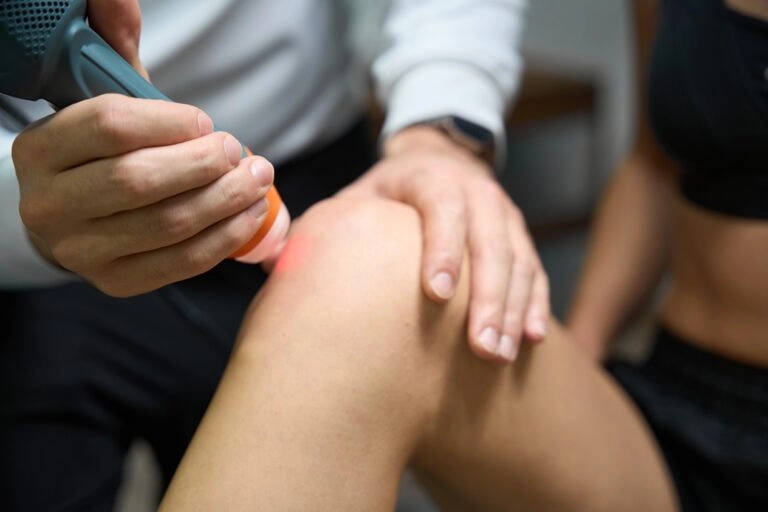Back pain is incredibly common, with many estimates stating that every adult will seek some form of medical care for back pain at least once in their lives. But there’s a big difference between mechanical and inflammatory back pain.
Finding relief from inflammatory back pain can be counterintuitive. Movement tends to help it while rest makes it worse. And for some, inflammatory back pain is something they will have to contend with for the rest of their lives. Luckily, there are effective management and relief options available.
Inflammatory Back Pain vs Mechanical Back Pain
Back pain is nothing new to the healthcare community. A 2016 study estimated that around 20% of the US population suffered from chronic pain. And a large majority of that chronic pain is thought to be back pain. More specifically, the low back or lumbar spine.
Chronic back pain has two major causes: mechanical and inflammatory. Unless you know what you’re looking for, it will be hard for you to tell the difference between the two. Luckily, they have slightly different traits that can tell you which is which, and therefore help you decide how to proceed with treatment or management.
Inflammatory Back Pain
Back pain caused by inflammation is generally described as:
- Having no known definite cause.
- Is characterized by stiffness, especially for about half an hour in the morning.
- Lessens with activity, stretching, exercise.
- Is at its worst during the second half of the night.
- Is often accompanied by pain in one or both buttocks.
Mechanical Back Pain
This type of back pain is generally described as:
- Pain that worsens with activity, stretching, or exercise.
- Pain that lessens with rest.
- Is not associated with stiffness in the morning or after rest.
- Pain that isn’t constant, but can get worse for short periods.
- Not associated with pain in the buttocks.
Inflammatory or Non-Inflammatory Back Pain
You may hear people refer to back pain as inflammatory and non-inflammatory. This is essentially the same as saying mechanical and inflammatory. Mechanical, or non-inflammatory back pain generally has a cause relating to the mechanics of the back and is often the result of injury or trauma.
The cause of non-inflammatory back pain doesn’t have to be sudden. For example, in instances where poor posture leads to back pain, this is considered non-inflammatory.
Further, non-inflammatory back pain may be accompanied by inflammation in the back as a natural reaction to injury. But this inflammation isn’t the cause of the back pain. Non-inflammatory back pain can often be treated effectively with conservative treatments, such as chiropractic spinal decompression.
When inflammation is the cause of back pain, then it’s considered inflammatory back pain. A much smaller subset of the population has inflammatory back pain, and there are a couple of causes for this, which we’ll discuss in the section below.
What Autoimmune Diseases Cause Back Pain
When the body begins to mistakenly attack parts of the body, it’s considered an autoimmune disease. Chronic neck and back pain can be caused by these autoimmune diseases:
- Rheumatoid Arthritis
-
- A disease in which the immune system attacks the joints all throughout the body.
-
- A rare kind of arthritis that affects the spine. More prevalent in men and more usually starts during early adulthood.
- Multiple Sclerosis
-
- MS is a serious disease in which the immune system mistakenly attacks the nerve fibers. MS can lead to back and neck pain.
- Psoriatic Arthritis
-
- A type of arthritis characterized by patches of red, dry, and itchy skin along with joint pain and inflammation.
Some other issues that may affect the neck or back but aren’t necessarily caused by inflammation include cervical spondylosis and osteoarthritis which are typically caused by natural aging.
Inflammatory Back Pain Treatment
Before we get into treatment options, it’s worth noting that there are some persistent myths out there. The first is that cracking the joints, whether by yourself or with the help of a medical professional, can cause arthritis. In reality, cracking your back won’t cause arthritis. Nor will cracking any other joint such as your knuckles or neck.
Talk To Your Doctor
If you think you have any kind of inflammatory back pain, make sure to mention this to your doctor. It’s common for inflammatory back pain to be misdiagnosed by general practitioners as mechanical back pain. But, for things like ankylosing spondylitis (AS), the longer you go without proper treatment, the more likely you are to suffer severe symptoms.
You should also see a rheumatologist immediately to start an effective management plan for this chronic condition.
Many people find relief initially from taking non-steroidal anti-inflammatory drugs (NSAIDs) and keeping active. Sometimes this is enough to manage AS. However, other people find that NSAIDs and keeping active aren’t enough. This is where chiropractic care and physical therapy can help.
Chiropractic Care and Physical Therapy
If you are looking for relief from AS or another type of inflammatory back pain, seeking out a Chiropractic office that has a physical therapist on staff is a great idea. These two medical professions complement each other very well and can both be beneficial as a part of your overall treatment or management plan.
A chiropractor can help with arthritis of all different kinds. And with the help of a physical therapist, many patients find significant relief. The typical management techniques for patients with AS involve chiropractic adjustments before the acute inflammation stage, flexion-distraction, posture correction, and plenty of exercises that are designed to keep the spine limber and prevent the vertebrae from fusing together, as can happen in extreme cases.
There is some evidence that this type of chiropractic care can help relieve pain and other symptoms of AS, although more studies need to be done on the subject.
Inflammatory Back Pain at Night
One of the worst things about inflammatory back pain is how it seems to get worse at night. This is because the inflammatory markers are allowed to settle when you’re not moving around. Many people find that they wake up from inflammatory back pain at night. Fortunately, there are a couple of simple things you can do to help get better sleep.
- Stretch Before and After Bed
-
- Performing your stretches both right before you go to bed and right after you wake up can help keep the pain at bay through the night. It can also help you start your day without the pain and stiffness common to inflammatory back pain.
- Mind Your Medications
-
- Some studies suggest that corticosteroids may be linked to insomnia. If you’re currently taking these, it could be one reason why you aren’t getting adequate sleep. You may also try taking NSAIDs right before bed to experience relief through the night.
- Inspect Your Pillow and Mattress
-
- If you’re sleeping with your spine out of alignment, it could be exacerbating your problem. Usually, a too-soft mattress or a too-large pillow is to blame. If you sleep on your side, try putting a pillow between your legs to keep your lumbar spine straight while you sleep.

Inflammatory Back Pain Exercises
There are several inflammatory back pain exercises and general pointers that you should discuss with your doctor. Many AS patients find that exercise and stretching are essential for relief.
- Cardio – These exercises increase your heart rate, boost mood, and release natural pain killers in the body. Try to stick to these low-impact cardio exercises:
- Swimming
- Walking
- Cycling
- Strength-Building – Concentrating on strengthening the core muscles can help you maintain posture and support your spine. Some of these include yoga exercises such as:
- The Bridge
- Plank
- Superman
- Glute Press
- Stretching – Stretching can help keep you limber, which can help manage pain and can also reduce the chances of your vertebrae fusing together due to AS.
- Seated thoracic stretch
- Seated figure 4 stretch
- Various neck stretches
- Cat and cow
- Upward and downward dog
Incorporating some of each of these stretches and exercises into your routine can help you effectively manage your inflammatory back pain.
Inflammatory Back Pain Management and Relief: Conclusion
Inflammatory back pain has many potential causes. Ankylosing spondylitis is a major cause of this for adults under 45 years old. And, although it’s somewhat rare, there are thought to be nearly 300,000 Americans suffering from it. Most inflammatory back pain is chronic and has no cure.
But, with a multifaceted approach that includes exercise, stretching, chiropractic back adjustments, physical therapy, NSAIDs, and help from a rheumatologist, you can effectively manage the pain and live a healthy and happy life.
Resources:
https://www.ncbi.nlm.nih.gov/pmc/articles/PMC6146950/
https://www.healthline.com/health/ankylosing-spondylitis/warning-signs
https://www.ncbi.nlm.nih.gov/pmc/articles/PMC5731838/
https://onlinelibrary.wiley.com/doi/full/10.1111/j.1440-1819.2011.02260.x
https://spondylitis.org/about-spondylitis/treatment-information/exercise/
https://orthop.washington.edu/patient-care/articles/arthritis/ankylosing-spondylitis.html#:~:text=About%20300%2C000%20Americans%20









